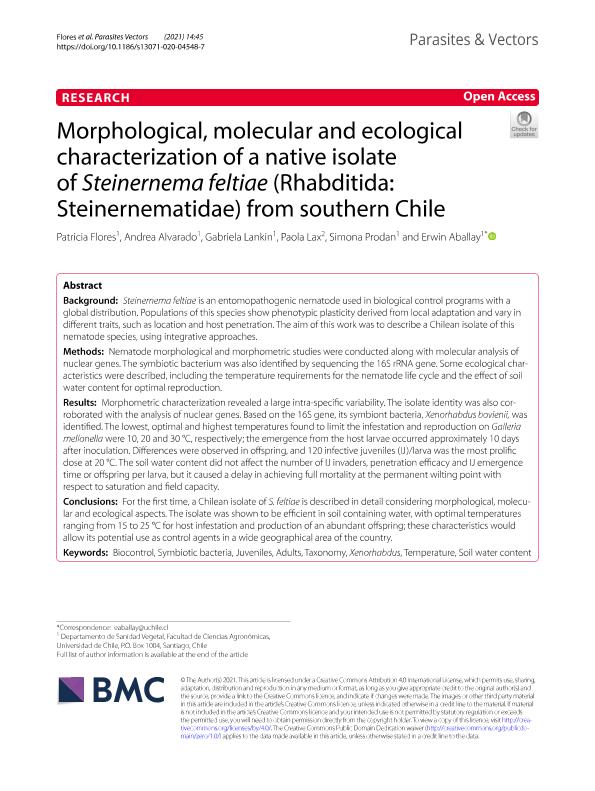Mostrar el registro sencillo del ítem
dc.contributor.author
Flores, Patricia
dc.contributor.author
Alvarado, Andrea
dc.contributor.author
Lankin, Gabriela
dc.contributor.author
Lax, Paola

dc.contributor.author
Prodan, Simona
dc.contributor.author
Aballay, Erwin
dc.date.available
2023-08-24T12:09:56Z
dc.date.issued
2021-12
dc.identifier.citation
Flores, Patricia; Alvarado, Andrea; Lankin, Gabriela; Lax, Paola; Prodan, Simona; et al.; Morphological, molecular and ecological characterization of a native isolate of Steinernema feltiae (Rhabditida: Steinernematidae) from southern Chile; BioMed Central; Parasites and Vectors; 14; 1; 12-2021; 1-13
dc.identifier.issn
1756-3305
dc.identifier.uri
http://hdl.handle.net/11336/209177
dc.description.abstract
Background: Steinernema feltiae is an entomopathogenic nematode used in biological control programs with a global distribution. Populations of this species show phenotypic plasticity derived from local adaptation and vary in different traits, such as location and host penetration. The aim of this work was to describe a Chilean isolate of this nematode species, using integrative approaches. Methods: Nematode morphological and morphometric studies were conducted along with molecular analysis of nuclear genes. The symbiotic bacterium was also identified by sequencing the 16S rRNA gene. Some ecological characteristics were described, including the temperature requirements for the nematode life cycle and the effect of soil water content for optimal reproduction. Results: Morphometric characterization revealed a large intra-specific variability. The isolate identity was also corroborated with the analysis of nuclear genes. Based on the 16S gene, its symbiont bacteria, Xenorhabdus bovienii, was identified. The lowest, optimal and highest temperatures found to limit the infestation and reproduction on Galleria mellonella were 10, 20 and 30 °C, respectively; the emergence from the host larvae occurred approximately 10 days after inoculation. Differences were observed in offspring, and 120 infective juveniles (IJ)/larva was the most prolific dose at 20 °C. The soil water content did not affect the number of IJ invaders, penetration efficacy and IJ emergence time or offspring per larva, but it caused a delay in achieving full mortality at the permanent wilting point with respect to saturation and field capacity. Conclusions: For the first time, a Chilean isolate of S. feltiae is described in detail considering morphological, molecular and ecological aspects. The isolate was shown to be efficient in soil containing water, with optimal temperatures ranging from 15 to 25 °C for host infestation and production of an abundant offspring; these characteristics would allow its potential use as control agents in a wide geographical area of the country.
dc.format
application/pdf
dc.language.iso
eng
dc.publisher
BioMed Central

dc.rights
info:eu-repo/semantics/openAccess
dc.rights.uri
https://creativecommons.org/licenses/by/2.5/ar/
dc.subject
ADULTS
dc.subject
BIOCONTROL
dc.subject
JUVENILES
dc.subject
SOIL WATER CONTENT
dc.subject
SYMBIOTIC BACTERIA
dc.subject
TAXONOMY
dc.subject
TEMPERATURE
dc.subject
XENORHABDUS
dc.subject.classification
Otras Ciencias Biológicas

dc.subject.classification
Ciencias Biológicas

dc.subject.classification
CIENCIAS NATURALES Y EXACTAS

dc.title
Morphological, molecular and ecological characterization of a native isolate of Steinernema feltiae (Rhabditida: Steinernematidae) from southern Chile
dc.type
info:eu-repo/semantics/article
dc.type
info:ar-repo/semantics/artículo
dc.type
info:eu-repo/semantics/publishedVersion
dc.date.updated
2023-08-16T11:12:06Z
dc.journal.volume
14
dc.journal.number
1
dc.journal.pagination
1-13
dc.journal.pais
Reino Unido

dc.journal.ciudad
Londres
dc.description.fil
Fil: Flores, Patricia. Universidad de Chile; Chile
dc.description.fil
Fil: Alvarado, Andrea. Universidad de Chile.; Chile
dc.description.fil
Fil: Lankin, Gabriela. Universidad de Chile.; Chile
dc.description.fil
Fil: Lax, Paola. Consejo Nacional de Investigaciones Científicas y Técnicas. Centro Científico Tecnológico Conicet - Córdoba. Instituto de Diversidad y Ecología Animal. Universidad Nacional de Córdoba. Facultad de Ciencias Exactas Físicas y Naturales. Instituto de Diversidad y Ecología Animal; Argentina
dc.description.fil
Fil: Prodan, Simona. Universidad de Chile.; Chile
dc.description.fil
Fil: Aballay, Erwin. Universidad de Chile.; Chile
dc.journal.title
Parasites and Vectors
dc.relation.alternativeid
info:eu-repo/semantics/altIdentifier/doi/http://dx.doi.org/10.1186/s13071-020-04548-7
dc.relation.alternativeid
info:eu-repo/semantics/altIdentifier/url/https://parasitesandvectors.biomedcentral.com/articles/10.1186/s13071-020-04548-7
Archivos asociados
